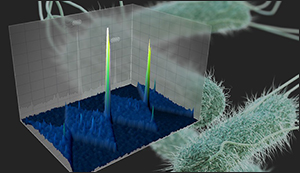Sorting good germs from bad, in the bacterial world
2. 9. 2015 | ASU | researchmatters.asu.edu
Your intestines are home to about 100 trillion bacteria. That’s more than the number of cells that comprise the entire human body. Armies of bacteria sneak into our bodies the moment we are born, uninvited but necessary guests.
For the most part, these bacteria are industrious and friendly. Some of them are even beneficial, helping with digestion and producing vitamins. A few miscreants, though, will kill us if we let them stay.

Sometimes the difference between harmless and harmful is miniscule. Take E. coli for instance. Billions of E. coli organisms live in the average person’s intestines. They go about their business causing no trouble whatsoever. However, one particular strain of E. coli, O157:H7, causes about 2,000 hospitalizations and 60 deaths in the U.S. every year. The differences between this strain and others are detectable only at the molecular level.
But how do we separate friend from foe? Determining whether or not bacteria are harmful usually requires growing cultures from food or infected patients. This is a time-consuming process that must be carried out in a laboratory. Since an estimated 9.4 million cases of food-borne illness occur each year in the U.S., we stand to gain much from new technologies that can rapidly identify microorganisms.
Scientists at Arizona State University’s Department of Chemistry and Biochemistry, in the College of Liberal Arts and Sciences, have developed a new device that could significantly speed up the identification process for harmful bacteria and other microorganisms. The team, led by professor Mark A. Hayes, hopes to create handheld, battery-operated devices that could deliver answers in minutes, instead of days.
Read more at ASU
Image Credit: Paul V. Jones
-jk-




